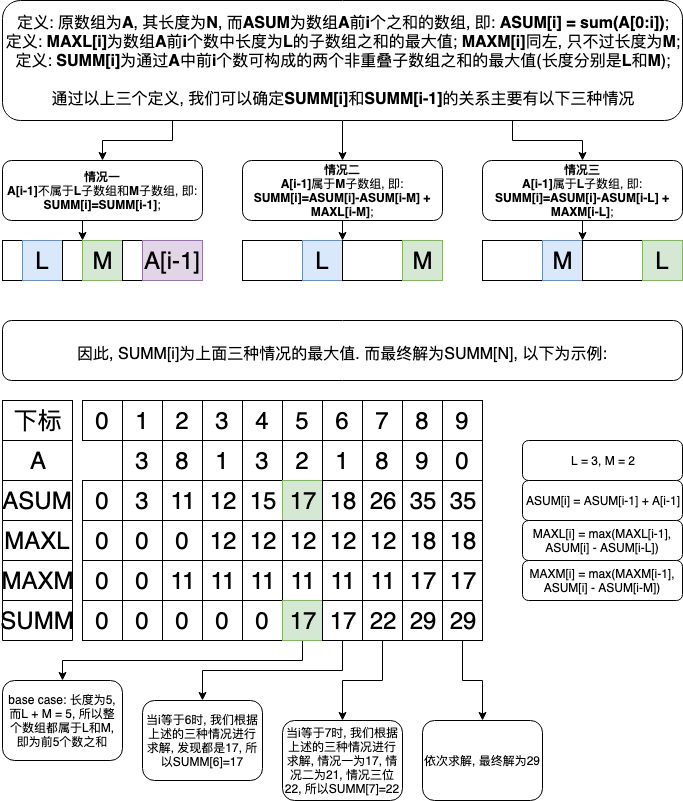4.9 KiB
4.9 KiB
题目地址
https://leetcode.com/problems/maximum-sum-of-two-non-overlapping-subarrays/
题目描述
Given an array A of non-negative integers, return the maximum sum of elements in two non-overlapping (contiguous) subarrays, which have lengths L and M. (For clarification, the L-length subarray could occur before or after the M-length subarray.)
Formally, return the largest V for which V = (A[i] + A[i+1] + ... + A[i+L-1]) + (A[j] + A[j+1] + ... + A[j+M-1]) and either:
0 <= i < i + L - 1 < j < j + M - 1 < A.length, or
0 <= j < j + M - 1 < i < i + L - 1 < A.length.
Example 1:
Input: A = [0,6,5,2,2,5,1,9,4], L = 1, M = 2
Output: 20
Explanation: One choice of subarrays is [9] with length 1, and [6,5] with length 2.
Example 2:
Input: A = [3,8,1,3,2,1,8,9,0], L = 3, M = 2
Output: 29
Explanation: One choice of subarrays is [3,8,1] with length 3, and [8,9] with length 2.
Example 3:
Input: A = [2,1,5,6,0,9,5,0,3,8], L = 4, M = 3
Output: 31
Explanation: One choice of subarrays is [5,6,0,9] with length 4, and [3,8] with length 3.
Note:
L >= 1
M >= 1
L + M <= A.length <= 1000
0 <= A[i] <= 1000
思路(动态规划)
题目中要求在前N(数组长度)个数中找出长度分别为L和M的非重叠子数组之和的最大值, 因此, 我们可以定义数组A中前i个数可构成的非重叠子数组L和M的最大值为SUMM[i], 并找到SUMM[i]和SUMM[i-1]的关系, 那么最终解就是SUMM[N]. 以下为图解:
关键点解析
- 注意图中描述的都是A[i-1], 而不是A[i], 因为base case为空数组, 而不是A[0];
- 求解图中ASUM数组的时候, 注意定义的是ASUM[i] = sum(A[0:i]), 因此当i等于0时, A[0:0]为空数组, 即: ASUM[0]为0, 而ASUM[1]才等于A[0];
- 求解图中MAXL数组时, 注意i < L时, 没有意义, 因为长度不够, 所以从i = L时才开始求解;
- 求解图中MAXM数组时, 也一样, 要从i = M时才开始求解;
- 求解图中SUMM数组时, 因为我们需要一个L子数组和一个M子数组, 因此长度要大于等于L+M才有意义, 所以要从i = L + M时开始求解.
代码
- 语言支持: Python
Python Code:
class Solution:
def maxSumTwoNoOverlap(self, a: List[int], l: int, m: int) -> int:
"""
define asum[i] as the sum of subarray, a[0:i]
define maxl[i] as the maximum sum of l-length subarray in a[0:i]
define maxm[i] as the maximum sum of m-length subarray in a[0:i]
define msum[i] as the maximum sum of non-overlap l-length subarray and m-length subarray
case 1: a[i] is both not in l-length subarray and m-length subarray, then msum[i] = msum[i - 1]
case 2: a[i] is in l-length subarray, then msum[i] = asum[i] - asum[i-l] + maxm[i-l]
case 3: a[i] is in m-length subarray, then msum[i] = asum[i] - asum[i-m] + maxl[i-m]
so, msum[i] = max(msum[i - 1], asum[i] - asum[i-l] + maxl[i-l], asum[i] - asum[i-m] + maxm[i-m])
"""
alen, tlen = len(a), l + m
asum = [0] * (alen + 1)
maxl = [0] * (alen + 1)
maxm = [0] * (alen + 1)
msum = [0] * (alen + 1)
for i in range(tlen):
if i == 1:
asum[i] = a[i - 1]
elif i > 1:
asum[i] = asum[i - 1] + a[i - 1]
if i >= l:
maxl[i] = max(maxl[i - 1], asum[i] - asum[i - l])
if i >= m:
maxm[i] = max(maxm[i - 1], asum[i] - asum[i - m])
for i in range(tlen, alen + 1):
asum[i] = asum[i - 1] + a[i - 1]
suml = asum[i] - asum[i - l]
summ = asum[i] - asum[i - m]
maxl[i] = max(maxl[i - 1], suml)
maxm[i] = max(maxm[i - 1], summ)
msum[i] = max(msum[i - 1], suml + maxm[i - l], summ + maxl[i - m])
return msum[-1]
扩展
- 代码中, 求解了4个动态规划数组来求解最终值, 有没有可能只用两个数组来求解该题, 可以的话, 需要保留的又是哪两个数组?
- 代码中, 求解的4动态规划数组的顺序能否改变, 哪些能改, 哪些不能改?
如果采用前缀和数组的话,可以只使用O(n)的空间来存储前缀和,O(1)的动态规划状态空间来完成。C++代码如下:
class Solution {
public:
int maxSumTwoNoOverlap(vector<int>& A, int L, int M) {
auto tmp = vector<int>{A[0]};
for (auto i = 1; i < A.size(); ++i) {
tmp.push_back(A[i] + tmp[i - 1]);
}
auto res = tmp[L + M - 1], lMax = tmp[L - 1], mMax = tmp[M - 1];
for (auto i = L + M; i < tmp.size(); ++i) {
lMax = max(lMax, tmp[i - M] - tmp[i - M - L]);
mMax = max(mMax, tmp[i - L] - tmp[i - L - M]);
res = max(res, max(lMax + tmp[i] - tmp[i - M], mMax + tmp[i] - tmp[i - L]));
}
return res;
}
};
